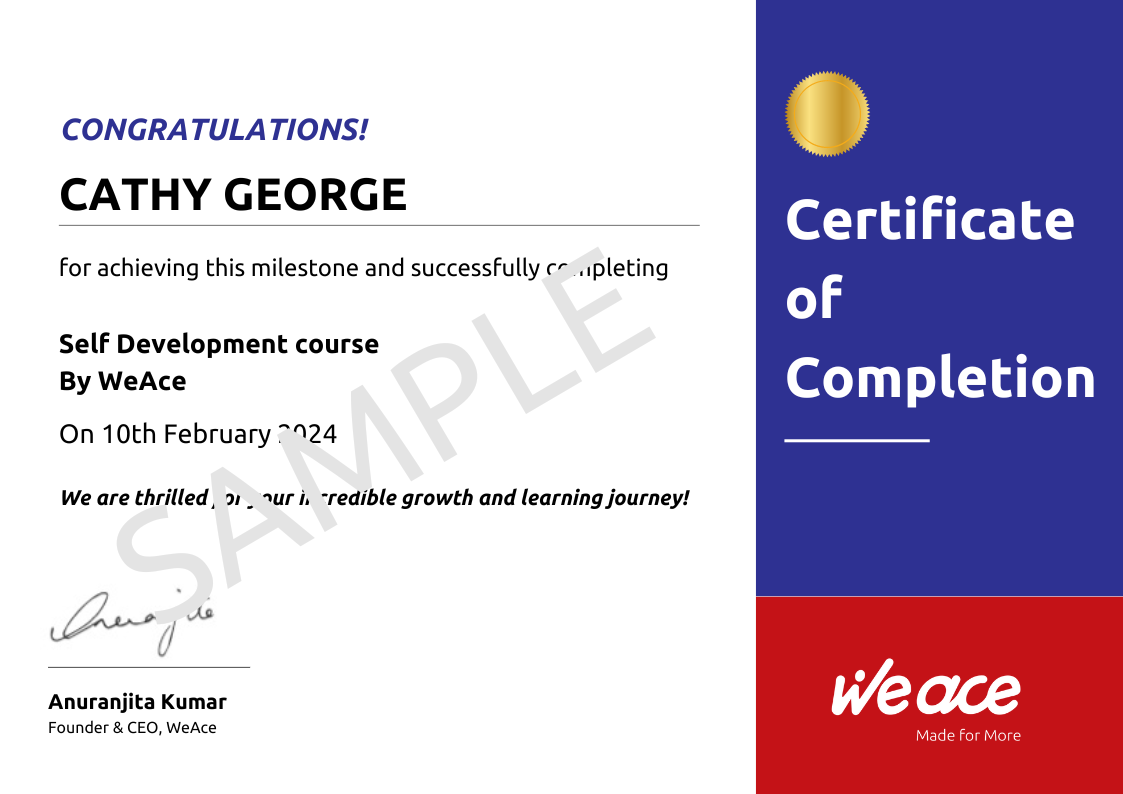Course Details
This is a half-day program for a batch size of 30 professionals.
A session on creative and innovative thinking can be highly beneficial for both personal and professional development. Here’s a detailed look at why you should consider attending such a session:
1. Enhancing Problem-Solving Skills
- Out-of-the-Box Thinking: Learn techniques to approach problems from new and unique perspectives.
- Complex Problem Solving: Develop skills to tackle complex problems with innovative solutions.
2. Fostering Innovation
- Idea Generation: Understand methods for generating a large number of ideas quickly (brainstorming, mind mapping).
- Innovation Frameworks: Learn frameworks and models for fostering innovation within organizations, such as Design Thinking and Lean Startup.
3. Improving Personal Growth
- Self-Expression: Enhance your ability to express unique ideas and perspectives.
- Personal Fulfillment: Experience the satisfaction and fulfillment that comes from creative expression and innovative accomplishments.
4. Boosting Professional Development
- Career Advancement: Develop skills that are highly valued in many industries, making you more competitive in the job market.
- Leadership Skills: Enhance your ability to lead with creativity and inspire innovation within your team.
5. Increasing Productivity and Efficiency
- Creative Problem-Solving: Apply creative thinking to improve processes and increase efficiency.
- Innovative Solutions: Find novel solutions that can save time and resources.
6. Encouraging Adaptability and Resilience
- Adaptability: Develop the ability to adapt to new situations and challenges with innovative approaches.
- Resilience: Build resilience by learning how to navigate and leverage uncertainty and change.
7. Enhancing Collaboration and Teamwork
- Collaborative Innovation: Learn how to foster a collaborative environment that encourages innovative thinking.
- Diverse Perspectives: Understand the importance of diverse perspectives in generating creative solutions.
8. Understanding Market and Consumer Needs
- Market Trends: Stay ahead of market trends by thinking creatively about future possibilities.
- Customer-Centric Innovation: Learn how to innovate based on a deep understanding of customer needs and preferences.
9. Cultivating a Creative Mindset
- Growth Mindset: Develop a mindset that embraces challenges and views failures as opportunities for growth.
- Curiosity and Exploration: Foster a sense of curiosity and a willingness to explore new ideas and concepts.
10. Gaining Practical Tools and Techniques
- Creative Techniques: Learn specific techniques such as SCAMPER, Six Thinking Hats, and the Lotus Blossom Technique.
- Innovation Tools: Familiarize yourself with tools and technologies that can aid in the innovation process.
Conclusion
Attending a session on creative and innovative thinking can provide you with the skills and mindset needed to approach problems and opportunities with fresh perspectives. Whether you aim to enhance your personal growth, boost your professional development, or foster a more innovative environment within your organization, such sessions offer valuable insights and practical tools to unlock your creative potential.
For more information on pricing and registration, contact [email protected]
Program Structure
structure for a session on creative and innovative thinking involves incorporating theoretical concepts, practical exercises, and interactive components. Here’s a detailed outline for a typical creative and innovative thinking program:
Program Structure for Creative & Innovative Thinking
1. Introduction and Orientation
- Welcome and Icebreaker Activities: Engage participants with icebreaker activities to create a comfortable and open environment.
- Program Overview: Introduction to the session's goals, agenda, and expected outcomes.
- Setting Ground Rules: Establishing guidelines for respectful communication and active participation.
2. Understanding Creativity and Innovation
- Definitions and Differences: Clarify the concepts of creativity and innovation, and explain how they differ yet complement each other.
- Importance of Creativity and Innovation: Discuss the significance of creative and innovative thinking in various aspects of life and work.
3. The Creative Mindset
- Growth Mindset vs. Fixed Mindset: Explore Carol Dweck’s concepts and the importance of a growth mindset for creative thinking.
- Embracing Curiosity and Risk-Taking: Encourage participants to cultivate curiosity and be willing to take risks and learn from failures.
4. Techniques for Creative Thinking
- Brainstorming: Teach effective brainstorming techniques to generate a large number of ideas.
- Mind Mapping: Use mind maps to visually organize thoughts and ideas.
- SCAMPER Technique: Introduce the SCAMPER (Substitute, Combine, Adapt, Modify, Put to another use, Eliminate, Reverse) method for creative problem-solving.
- Six Thinking Hats: Explain Edward de Bono’s Six Thinking Hats method for looking at problems from different perspectives.
5. Innovation Frameworks and Models
- Design Thinking: Teach the stages of design thinking: Empathize, Define, Ideate, Prototype, and Test.
- Lean Startup: Introduce the Lean Startup methodology, including build-measure-learn cycles.
- Blue Ocean Strategy: Discuss creating uncontested market space and making the competition irrelevant.
6. Practical Application and Exercises
- Case Studies: Analyze real-world examples of successful creative and innovative solutions.
- Group Activities: Engage in group activities that apply creative thinking techniques to solve problems.
- Role-Playing: Simulate scenarios where participants practice innovative thinking in a controlled environment.
7. Tools and Technologies for Innovation
- Idea Management Software: Introduce tools that help capture, develop, and manage ideas (e.g., Trello, Miro, IdeaScale).
- Prototyping Tools: Discuss tools for creating prototypes (e.g., Sketch, InVision, 3D printing).
8. Building a Creative Environment
- Encouraging Collaboration: Foster an environment that supports collaboration and the sharing of ideas.
- Diverse Perspectives: Emphasize the value of diversity in teams for enhancing creative and innovative outcomes.
- Workplace Culture: Discuss how to create a workplace culture that encourages experimentation and rewards creativity.
9. Personal Action Plan
- Goal Setting: Help participants set personal and professional goals related to creative and innovative thinking.
- Implementation Plan: Develop a plan to apply the techniques and tools learned during the session to real-life situations.
10. Evaluation and Feedback
- Participant Feedback: Collect feedback to evaluate the effectiveness of the session and identify areas for improvement.
- Continuous Improvement: Encourage participants to continue practicing creative and innovative thinking beyond the session.
Additional Elements
- Guest Speakers: Invite experts in creativity and innovation to share their insights and experiences.
- Resource Materials: Provide participants with handouts, books, and online resources for further learning.
- Certification: Offer a certificate of completion to participants who successfully complete the program.
Conclusion
A well-structured program on creative and innovative thinking has to be engaging, interactive, and practical. By combining theoretical knowledge with hands-on exercises and real-world applications, participants can develop the skills and mindset needed to think creatively and innovate effectively. This program structure ensures a comprehensive learning experience that equips individuals with the tools and confidence to foster creativity and innovation in various settings.
Get your certificate of completion

-
DURATION 3 Hour(s)
-
LEVEL Entry Level (0-2 years), Junior Level (2-7 years), Mid Level (8-15 years), Senior Level (15+ years)
-
FORMAT Online Instructor Led
-
CERTIFICATION Yes
-
Academy Leadership & Management
-
Topics Negotiation & influencing, Innovation
-
KEY LEARNING AREA Upskilling, Sustainability
-
SKILLS Innovation, Strategy
-
BEST FOR Working Professionals
-
TRAINER WeAce

/filters:strip_exif()/wocademy/images/logo/rYmTH2mhGvAyHn8P2BduHm0stWrOt87QKl5DdTs0.png)
 Led
By: WeAce
Led
By: WeAce
 Online
Self
Paced
Online
Self
Paced
/filters:strip_exif()/wocademy/images/logo/6cFXKE2izcv8Cb5IVg2cpbvt9DILdUotL3Q0VOvH.jpg)
/filters:strip_exif()/wocademy/images/logo/fvGU5x8KErnMaZrJUI0baY6xyn7azxCTl87BPlZB.jpg)
/filters:strip_exif()/wocademy/images/logo/gsQTeglpz2nqoyusls9ZQTRocyQI2LLDlDgEv3Ie.jpg)
/filters:strip_exif()/wocademy/images/logo/ztMeVWmtdSTmthFaQtTw26jkyFPPUa3twFgQNuJS.png)
/filters:strip_exif()/wocademy/images/logo/sz7F5SP1TFY3ZD45ho8Wx9tA1LBTZVxPNH3mCn1n.jpg)
/filters:strip_exif()/wocademy/images/logo/thHktETfDvNkRw5g4Jtq4pMtteKpiCmpJ9XMYOCt.jpg)
/filters:strip_exif()/wocademy/images/logo/PjcK7Oyt4mCiGS9j3OBmfd0P9YyVs698XNYb6dUK.jpg)